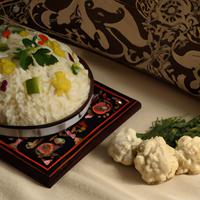
1 serving (100 grams) contains 25 calories, 2.0 grams of protein, 0.3 grams of fat, and 5.0 grams of carbohydrates.

Log this food in SnapCalorie

Nutrition Information
Calories |
50 | ||
|---|---|---|---|
% Daily Value* |
|||
| Total Fat | 0.6 g | 0% | |
| Saturated Fat | 0.2 g | 1% | |
| Polyunsaturated Fat | 0 g | ||
| Cholesterol | 0 mg | 0% | |
| Sodium | 60 mg | 2% | |
| Total Carbohydrates | 10 g | 3% | |
| Dietary Fiber | 4 g | 14% | |
| Sugars | 4 g | ||
| protein | 4 g | 8% | |
| Vitamin D | 0 mcg | 0% | |
| Calcium | 44 mg | 3% | |
| Iron | 0.8 mg | 4% | |
| Potassium | 598 mg | 12% | |
* Percent Daily Values are based on a 2,000 calorie diet. Your daily values may be higher or lower depending on your calorie needs.
Food Attributes
Source of Calories
About Culiflower rice
Cauliflower rice is a low-carb alternative to traditional grain-based rice, created by finely chopping or pulsing raw cauliflower into small, rice-like granules. Native to low-carb and gluten-free diets, this versatile ingredient has roots in modern health-conscious cooking and is widely used in keto, Paleo, and vegetarian cuisines. Packed with vitamins C and K, fiber, and antioxidants, cauliflower rice supports digestive health, promotes immunity, and aids in reducing inflammation. It is naturally low in calories and carbohydrates, making it ideal for weight management and blood sugar control. However, its lower protein content compared to other rice alternatives may not satisfy all dietary needs unless paired with protein-rich sides. Whether sautéed, steamed, or baked, cauliflower rice easily absorbs flavors, making it a creative substitute in stir-fries, bowls, and curries while boosting your daily vegetable intake.



